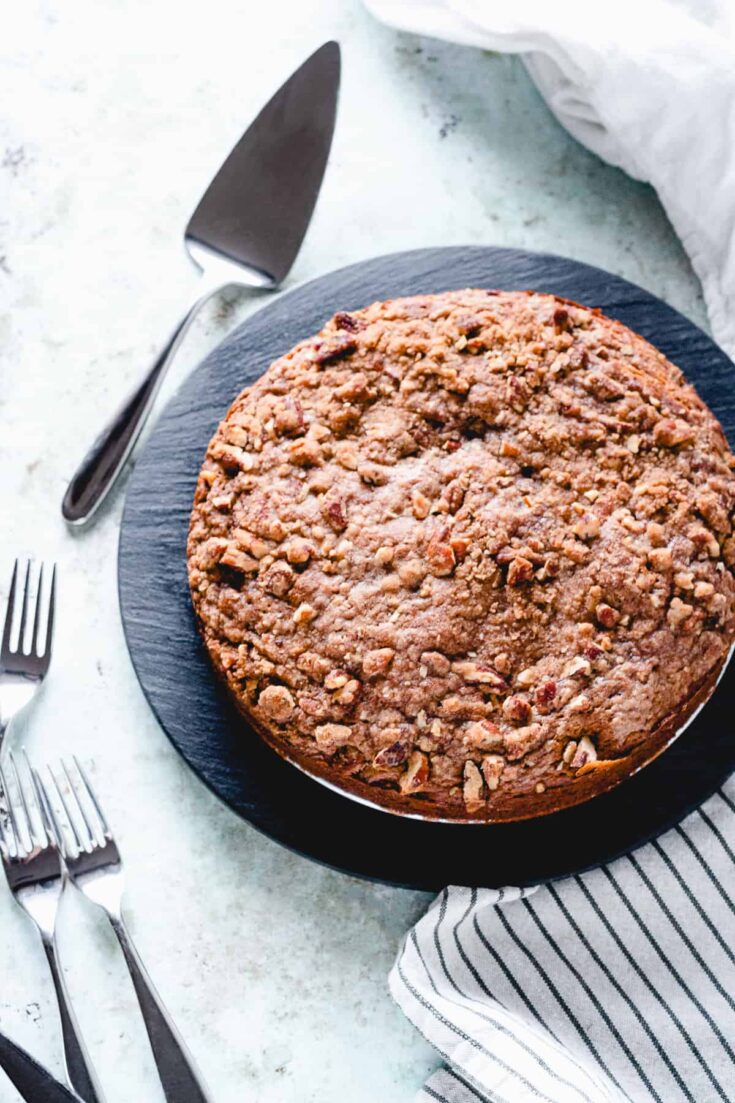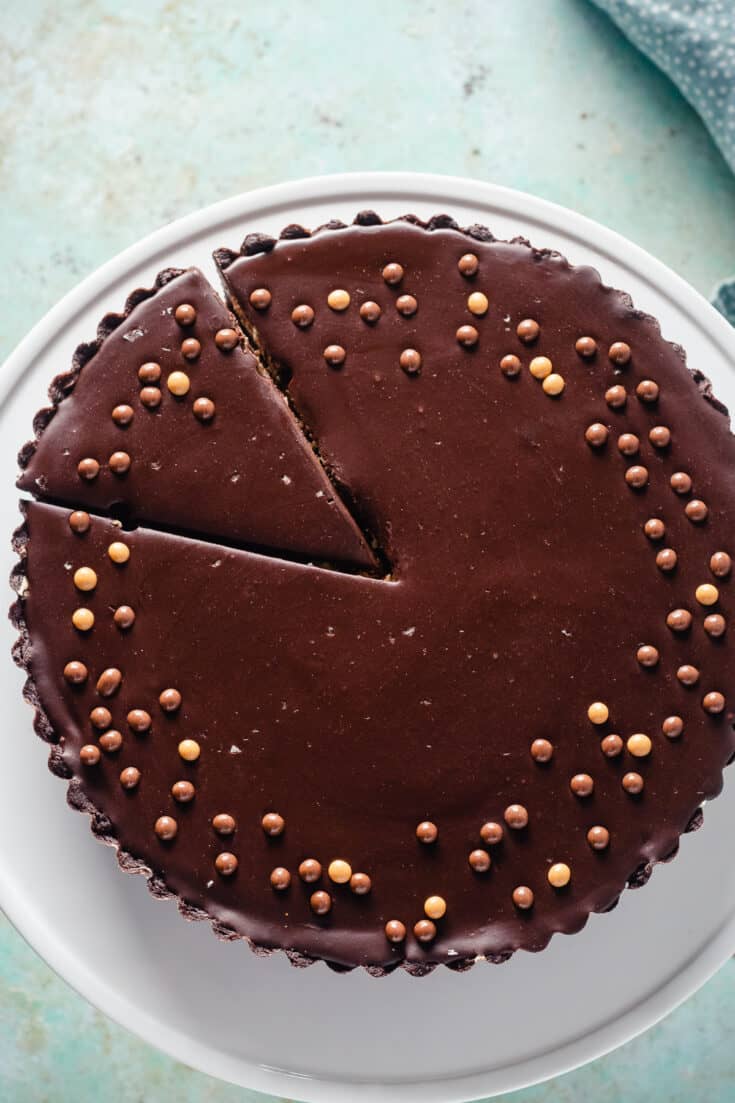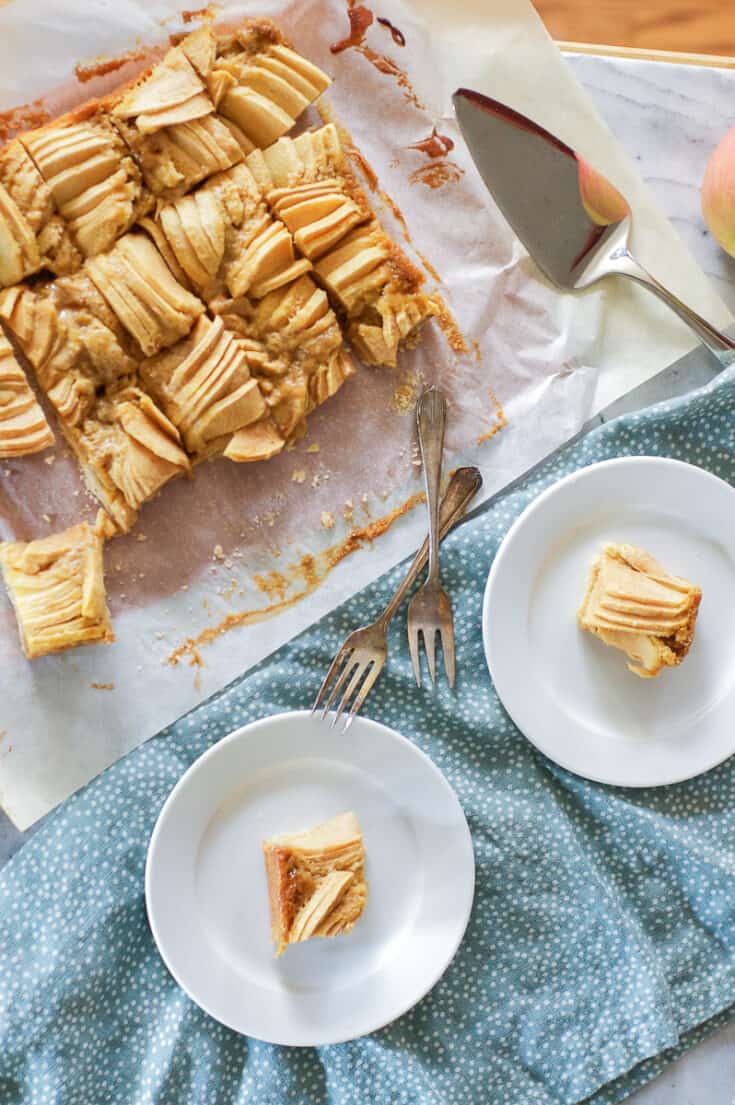I may earn from purchases through links in this post.
A Thanksgiving feast isn’t complete without something sweet to close out the celebration.
Here is a collection of some of my favorite classic and not-so-classic Thanksgiving desserts, from apple pie to pumpkin bread to a show-stopping cranberry curd tart.

Thanksgiving Desserts
This pumpkin bread makes a generously sized loaf. Be sure to use a loaf pan that measures at least 9"x5" around the top. If your loaf pan is smaller, reserve some of the batter to bake as muffins or a mini loaf.
This is a dense, moist, craggy-topped pumpkin bread with a generous amount of spices. You can feel free to play around with the spices, depending on your preferences and what you have around. Cinnamon is the star here, but the nutmeg, ginger, and cardamom give this a wonderful complexity.
The thing that makes this pumpkin bread extra special is that it gets brushed with butter and showered with cinnamon sugar after it comes out of the oven. You can skip the step if you want, but it's hardly any work and it's delightful.
This cranberry curd tart uses a press-in shortbread crust inspired by one Alice Medrich uses in everything. This one has a bit of orange zest and powdered sugar to keep it tender. The cranberry curd itself is a riff on one I've been making for years that's rounded out with a generous splash of vanilla, some freshly squeezed orange juice from the orange you just zested, and an optional splash of any orange liqueur you like (but don't bother going out to buy Grand Marnier or Dry Curacao just for this). The tart crust can be made and baked up to two days ahead, and the curd can be cooked and chilled up to a week in advance, you can then assemble and bake the tart on the day (or day before) you want to eat it. The meringue is totally optional, but because the tart leaves you with extra egg whites from the curd, it's easy to go that extra step and add the meringue. The amount of meringue isn't as much what you would typically do for a towering lemon meringue pie, but it's plenty for piping decoratively on the top (and enough to cover the whole top with dots like you see pictured if you wanted to do that). You'll need a 9-inch tart pan with a removable bottom for this recipe.
This caramel pumpkin tart is a spin on a traditional pumpkin pie. The caramel makes the flavor fuller and the texture lighter than the traditional version.
Don't be afraid of making caramel. Just keep an eye on it once you get started and be swift and decisive when it's time to remove it from the heat.
Don't be tempted to skip the step of straining the filling. It's essential to the lush, smooth texture of the filling.
I like to serve it with whipped cream.
This apple pie is everything I look for in a classic apple pie. The crust is flaky, the filling is sturdy enough to slice but gooey enough to feel rich. It's got a mix of white and brown sugar for depth of flavor and a generous amount of cinnamon to keep the flavor profile simple and classic.
My favorite apple pies are made with a mix of apple varieties like Empires, Cortlands, Liberty, and Northern Spy. But if you are limited in what apples are available to you, Granny Smiths are a solid option.
Don't use Honey Crisp or other extra sweet and juicy apples—they're too sweet to handle extra sugar and their texture is too soft to hold up in baking.
The apples in this pie retain a bit of a firm bite. I like them that way, but if you want your apples totally soft, slice them thinner than I do here.
This crisp is so easy to make. The topping comes together quickly and can hang out while you work on the apples
When you melt the butter, you can take the extra step of browning it for more flavor (I usually do)—it brings out the nutty flavor and is really delightful—but it's not necessary.
Feel free to play around with the spices. I love this particular combination, but you can simplify and just use cinnamon or throw in other warm baking spices like nutmeg or cloves.
Use any of your favorite baking apples here. Granny Smith, Braeburn, Mutsu, and Haralson are all good options. A combination of apple varieties works well, too.
This tart uses a press-in shortbread crust inspired by one Alice Medrich uses in everything. This one has a bit of lime zest for fragrance and flavor and powdered sugar to keep it tender.
The lemon ginger curd itself is a riff on one I've been making for years—that one uses Meyer lemons, whereas this one calls for the more commonly available Eureka lemons. The fussiest part is grating the ginger to squeeze out enough juice. A ceramic ginger grater or microplane zester makes this job doable.
The tart crust can be made and baked up to two days ahead, and the curd can be cooked and chilled up to a week in advance, you can then assemble and bake the tart on the day (or day before) you want to eat it.
The meringue is totally optional, but because the tart leaves you with extra egg whites from the curd, it's easy to go that extra step and add the meringue. The amount of meringue isn't as much what you would typically do for a towering lemon meringue pie, but it's plenty for piping decoratively on the top (and enough to cover the whole top with dots like you see pictured if you wanted to do that). You'll need a 9-inch or 9.5-inch tart pan with a removable bottom for this recipe.
This pumpkin coffee cake has a tender crumb, a generous mix of autumnal spices, and two layers of brown sugar pecan streusel.
It slices beautifully, travels well, and keeps for several days, which make it versatile.
I love this cake for breakfast alongside a mug of coffee, but it also works beautifully for dessert.
THIS IS MY OFFICIAL barter recipe. If I ask anyone for a recipe, I hand over this one in exchange. Everyone needs a good nut bar, and this one comes together quickly. The shortbread base is baked all the way through while the nut caramel iscooked on the stove and then poured onto the cooled base. After it has cooled, it’s ready to be cut. (Do not refrigeratebefore cutting or else the nut caramel becomes rock-hard.) While using a knife to cut the bars is best for yield, sometimesI punch the bars out using a rectangular cookie cutter to get a cleaner edge. Any kind of nut can be used for these bars,but honey and walnuts are naturals together.
This dessert is incredibly simple: just carefully layered slices of apples brushed with butter and sprinkled with cinnamon and sugar arranged in a dome that looks a bit like a beehive. But the flavor is incredibly complex. I couldn't resist tweaking Prueitt's version a little. I browned the butter because apples and brown butter are delightful together, but you can skip that step and just use melted butter if you prefer. I also reduced the sugar a bit--from 3/4 of a cup to 2/3 of a cup--because that felt like plenty. You'll want to use an apple that doesn't turn to mush in the oven. Prueitt calls for Granny Smith's; I like it with Empires. I used an apple corer like the one linked below to remove the cores, and my favorite peelers are also linked below. If you don't have a corer, feel free to peel and slice the apples in any way that preserves their lovely round edges. The apple jelly gives the beehive its lovely shine, but you could leave it off if you don't want to bother--the flavor won't suffer.
This chocolate peanut butter tart is like a giant peanut butter cup with a crisp chocolate shortbread crust, a light peanut butter mousse filling with whipped cream and crème fraîche (that I could eat with a spoon on it's own). I like to use Skippy (or a similar style) creamy peanut butter rather than an all natural peanut butter because I find it blends better. I recommend using a high quality cocoa powder in the crust like Valrhona or Droste rather than the really cheap stuff (it's a place where splurging a little makes a big difference). I go for a chocolate in the 60-60% cacao range in the ganache, but it will work with any percentage of milk or dark chocolate you like (but I'd avoid chocolate chips which are made with additives that prevent melting smoothly). This tart is rich, so I like to serve it in small slices (10-12 slices per tart) but you do you.
These brown butter apple bars occupy the space between a tart and a cookie. Their base is one of my all time favorite shortbread crusts, that’s buttery, crisp, easy and has never let me down. You can brown the butter for the crust as well if you want more of that nutty brown butter flavor. The brown butter custard layer is infused with a cinnamon stick and has caramel-molasses notes from the brown sugar. When most home cooks need to slice apples, they start by slicing them down the middle through the core and then quarter them and remove the core from each wedge. One thing I’ve observed through watching many chefs in action is that most professionals slice apples by cutting the apple on each side close to the core leaving a square core and four pieces of apple that are easy to slice. Not surprisingly, the professional way is more efficient, and it’s the method I recommend for slicing the apples for this recipe. You can use any firm baking apple you like for these. I used Fuji apples here. These are best the day they are made, but can keep well in the refrigerator for a couple of days.
In this banana custard tart, bananas are steeped in a cream and sugar mixture to infuse the banana flavor, and then the bananas are strained out to make a silky smooth custard.
This tart uses my favorite easy chocolate shortbread crust, which is a cinch to make.
It also gets topped with brown sugar Italian meringue, which conveniently uses up the egg whites left over from the custard filling. It's easier to separate eggs when they are cold, so separate these straight out of the refrigerator.
I like to use dark brown sugar here for the extra molasses flavor. The nutmeg helps bring out the banana flavor. Freshly grated nutmeg is worth the trouble if you have a microplane.
You can make the crust up to a day ahead of time. You can make the meringue while the tart is chilling.
This works with a 9- or 9.5-inch tart pan.
This pumpkin tea cake is generous with the spices and full of those warm baking spice flavors. I ask that you please freshly grate the nutmeg for this (get whole nutmeg and use a microplane). It makes a difference. I usually eyeball the nutmeg because grating it into any kind of measuring container is a pain and it doesn’t weigh enough for most scales to accurately register. Usually, I try to use about 2/3 of a whole nutmeg. I made this batch in mini loaf pans that I got from King Arthur Flour. I usually make it in a standard loaf pan, and the instructions I’m giving will be for that. (If you use small loaf pans, they take about 45 minutes to bake.)
The crust has a higher ratio of butter to flour than many pie crusts, which makes it extra flaky. This recipe works best with American butter and not higher fat European butters.
It's a simple and forgiving dough to work with. The sugar in the dough helps with browning, but doesn't make the crust itself sweet, which makes the dough flexible enough to work with sweet or savory fillings.
This crust works well for rustic free-form galettes or intricate lattice crusts.
I include instructions for blind-baking here, that is, baking the crust without filling, but you can use this with any standard pie recipe.

















